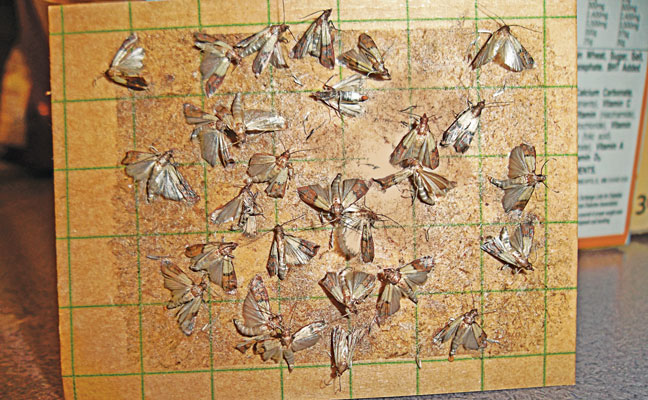-

Whether they originated at the grocery store or
in the kitchen pantry, IMM are unwelcome guests
at residential accounts. Photo: Mark Sheperdigian, BCEIMM is the single most-common SPP of homes and grocery stores.
- Pheromone traps may be the problem in homes with chronic activity.
The Indianmeal moth (Plodia interpunctella, or IMM) is the single most-common stored product pest (SPP) in retail food stores. That also is why it is the single most-common SPP in homes.
With a life cycle of about six weeks, they may go unnoticed, and suddenly the moths start flying. Because of this, many PMPs seem to believe that adding a pheromone trap adds value to their home service. And while traps can give a good indication of the extent of an infestation, they also can cause trouble by attracting male IMM from outside the home.
You may have seen a home with a pheromone trap that still catches IMM long after the infested product is gone.
Thorough inspections yield no other sources, and yet the moths continue. The guessing begins.
IMM will feed on many things; oddball sources include dried weed arrangements, macaroni art, and even rodent bait. Some sources are hard to find, and you might conclude you are missing it. That’s a reasonable conclusion, but a single pheromone trap with a fresh lure won’t help you find it. The pheromone output of the lure starts high and gradually reduces over months until it trails off to nothing. A fresh lure can bring in males from up to 50 feet in most conditions — and considerably farther when it’s calm.
A TRICK FOR TRAPS

Mark Sheperdigian
In commercial accounts, IMM lures are replaced every three months to keep the traps as attractive as possible. Still, there is value in saving the old lures and keeping them dated and sealed. Lures that are six, nine or 12 months old are still putting out pheromone at low levels and will attract IMM males from short distances. Traps using these “low-output” lures will only catch moths that are nearby. Several in a room may narrow your search nicely. One in every room may yield surprising results. I once found several infested cookies in a bedroom where a child had hidden them in the heat duct for later and forgotten about them.
Before using “light loads,” though, try removing the trap altogether. A fresh pheromone lure can pull in IMM males from outside. If there is indeed an infestation in a wall or under a kitchen cabinet, the residents will continue to see moths sitting on the walls or flying around at dusk. If activity stops only in the cold months, it tells you the source is affected by the weather.
AN ALL-MALE ‘REVIEW’
As a final note, it isn’t true that a pheromone trap will start an infestation by attracting IMM into any building. Sex pheromones only attract males, and males cannot start an infestation by themselves. Females avoid high concentrations of pheromone as it signals high competition. This is very reassuring, but few homeowners are satisfied with knowing the moths they see are only males. It may be best to only use old lures in homes, if you use them at all.
Leave A Comment